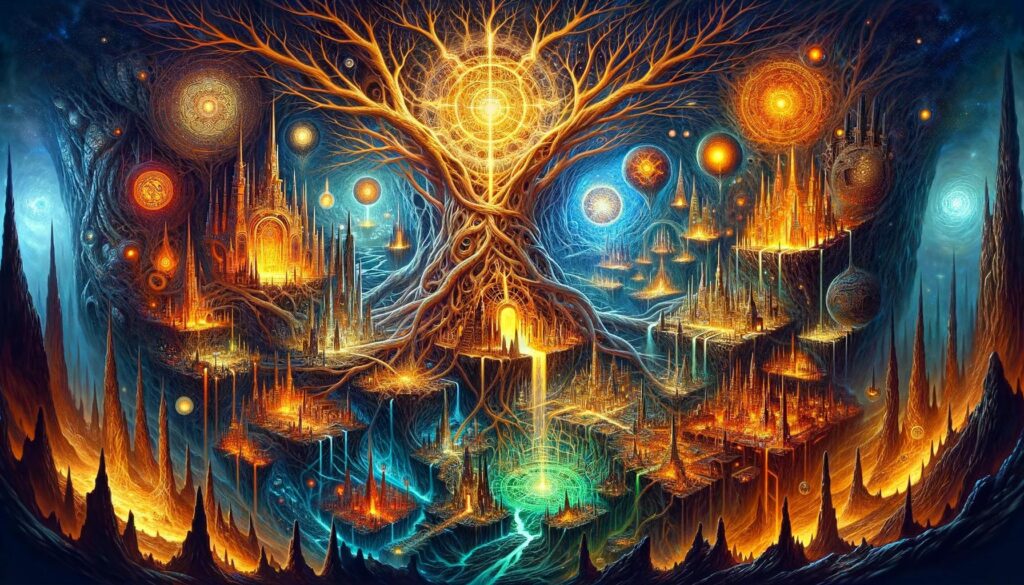Dwarves, Nidavellir (Svartalfheim), Norse Cosmology, Norse Mythology, Tales of the Gods, The Nine Worlds, Yggdrasil (World Tree)
The Interconnected Realms: Nidavellir’s Place in Yggdrasil and Norse Cosmology
Introduction to Norse Cosmology and Yggdrasil
Norse cosmology, rich in mythology and symbolism, presents a fascinating tapestry of interconnected realms and cosmic structures. Central to this cosmological framework is Yggdrasil, the immense and sacred tree that connects the nine realms of the Norse universe. These realms, each unique and integral to the Norse understanding of the universe, include Asgard, Midgard, Jotunheim, Vanaheim, Alfheim, Svartalfheim (also known as Nidavellir), Helheim, Muspelheim, and Niflheim.
Understanding Yggdrasil: The Cosmic Tree
Yggdrasil, often described as an ash tree, stands as the central axis of the Norse cosmological system. It is not just a physical entity but a symbolic representation of the Norse worldview. The tree’s roots delve into various realms, while its branches reach the heavens, indicating a connection between all forms of existence. The health of Yggdrasil is paramount, as it reflects the state of the universe. The tree is tended by the Norns, who shape the destinies of both gods and men.
Nidavellir: The Realm of Dwarves
Nidavellir, also known as Svartalfheim, is the realm of the dwarves, master smiths, and craftsmen of the Norse world. This subterranean realm is characterized by its intricate mines, forges, and dark, cavernous landscapes. The dwarves of Nidavellir are renowned for their skills in metallurgy and craftsmanship, creating some of the most powerful and magical items in Norse mythology, including Thor’s hammer, Mjolnir.
The Dwarves: Custodians of Ancient Knowledge
The dwarves of Nidavellir are more than mere craftsmen; they are custodians of ancient knowledge and wisdom. Their skills are unparalleled, making them integral to the balance and function of the Norse cosmological structure. Their creations often have profound effects on the events within the other realms, especially in the tales involving the gods of Asgard.
The Architecture and Landscape of Nidavellir
The Role of Nidavellir in Norse Myths
Nidavellir features prominently in several Norse myths, particularly those involving the Aesir, the pantheon of gods led by Odin. One of the most notable stories is the creation of Mjolnir, Thor’s hammer, which was forged by the dwarves Brokkr and Sindri. This tale underscores the importance of Nidavellir’s inhabitants and their creations in maintaining cosmic balance and order.
Nidavellir’s Interaction with Other Realms
The interactions between Nidavellir and other realms, such as Asgard and Midgard (the human world), are crucial in Norse mythology. The exchange of goods, knowledge, and sometimes conflicts between these realms highlights the interdependency within the Norse cosmos. The dwarves’ creations often play a pivotal role in the events unfolding across Yggdrasil.
Mythological Artifacts Originating from Nidavellir
Symbolic Significance of Nidavellir
Nidavellir is not just a physical realm but also a symbol of the Norse values of craftsmanship, skill, and the pursuit of knowledge. The dwarves embody these values with their deep understanding of the material world. Their realm represents the depth of the earth, both literally and metaphorically, a place where hidden knowledge and resources can be found.
The Contrast with Other Realms
Nidavellir’s dark, subterranean nature contrasts sharply with the bright skies of Asgard or the balanced Midgard. This contrast highlights the Norse belief in the balance of opposites and the interconnectedness of different aspects of the cosmos. Each realm plays a unique role, and their interactions are vital for the overall harmony of Yggdrasil.
Nidavellir in Modern Interpretations
In contemporary media and literature, Nidavellir has captured the imagination of many, often depicted as a realm of wonder and mystery. Its portrayal varies, but the core elements of dwarven craftsmanship and deep underground realms remain consistent. These interpretations continue to bring Norse mythology to new audiences, illustrating the enduring appeal of these ancient stories and concepts.
The Lasting Legacy of Norse Cosmology
The influence of Norse cosmology, and particularly the role of realms like Nidavellir, extends far beyond historical texts. It has shaped modern storytelling, fantasy literature, and even aspects of popular culture. This lasting legacy is a testament to the depth and richness of Norse mythology and its ability to capture the human imagination across ages.
Conclusion: The Integral Role of Nidavellir in Norse Cosmology
In conclusion, Nidavellir, or Svartalfheim, is an essential realm within the complex structure of Yggdrasil and Norse cosmology. It represents a physical space and a deep-seated cultural value of craftsmanship and knowledge. The interconnectedness of Nidavellir with other realms underlines the holistic and interconnected nature of the Norse cosmos, where each component is crucial to the balance and function of the whole. The enduring fascination with Norse mythology and realms like Nidavellir continues to inspire and intrigue, demonstrating the timeless appeal of these ancient tales.

